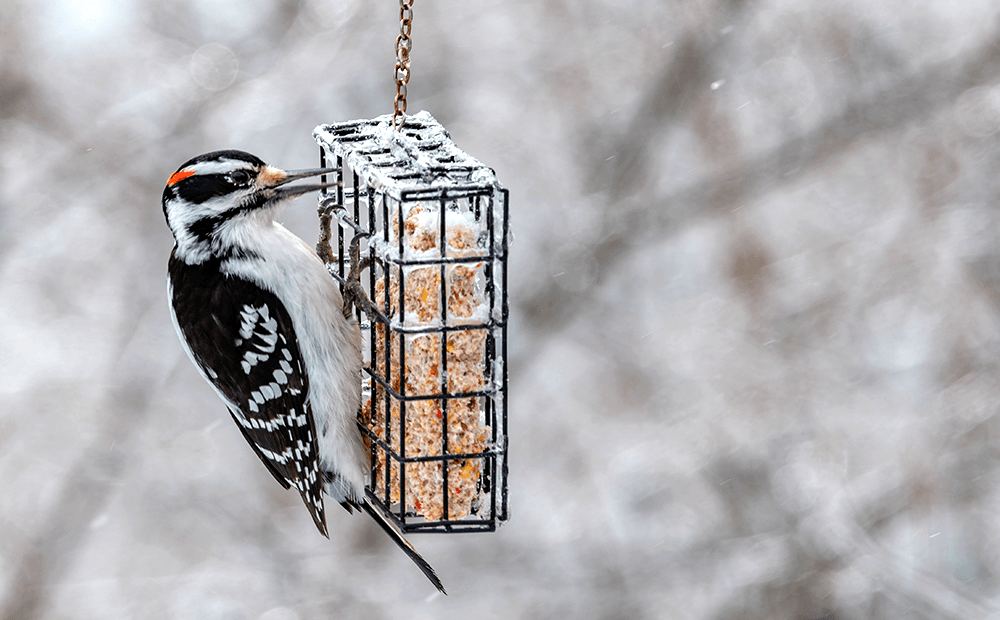HOW TO FEED BIRDS IN THE WINTER
While life becomes cold and dreary during Indiana winters, the beautiful birds in our area continue to brave the cold in search of food, water, and shelter. You can turn your wintery yard into a safe haven for colorful, musical birds and take up a new bird watching hobby!
Birds You’ll See During Indiana Winters
Indiana is located in the Mississippi flyway. We are in the direct path of thousands of birds as they migrate north and south. We also have local species that call Indiana home all year round. By creating a bird-friendly yard, species from near and far will be attracted to your home and begin relying on you as a source of food and shelter. You can never be sure exactly what types of birds you’ll spot during the winter, but some you can expect are:
Woodpeckers
Northern Cardinals (our state bird!)
Finches
Sparrows
Chickadees
Blue Jays
Dark-eyed Junco
Bluebirds
Wrens
Choosing Bird Food and Feeders
Not all our aviary friends like the same food or have the same preference for the type of feeder. Just like people, some birds are omnivores; some are carnivores, and some people like eating spaghetti off of a plate; others will grab a bowl. As a general rule, most birds you’ll see in your backyard love seeds, but you may have a few that love eating fruit and insects or some predatory birds that eat meat. If you’re trying to attract a certain type, you can research their favorite food and what type of feeder they prefer.
For finches and chickadees, try a mesh sock with millet and small seeds.
To attract woodpeckers, use hanging suet feeders.
Bluebirds love dishes with mealworms.
Cardinals and blue jays crave acorns, corn, beechnuts, and peanuts. Use large, open platform feeders.
An assortment of seeds will always attract sparrows, and you’ll likely attract a wide array of birds with them, too.
If you spot some ducks or geese in winter, remember never to feed them bread. Try oatmeal, corn, pumpkin, and sunflower seeds.
Birds are so fun to watch, especially during winter when there isn’t much else to do in your yard. Some people keep a checklist of local birds or even try their hand at photographing them. Not only are you entertaining yourself, but you are also encouraging a healthy ecosystem.
How Do You Feed Birds in the Winter?
Once you’ve selected your type of feed and feeder, you’ll want to set them up in an optimal arrangement. If you’re using hanging feeders, place them somewhere that leftovers can drop down in a space where different birds can clean up what the others don’t want. Standing feeders need to be placed somewhere sturdy that is accessible to both birds and you! You don’t want re-filling the feeder to turn into a huge task that becomes a chore to do every time. Be prepared to regularly clean feeders and the areas you place them in: birds can be messy! Whether it’s leftover scattered seeds or droppings, you’ll need to commit to keeping it tidy.
If you want birds to stay in your yard during winter, also provide water and shelter. Being a one-stop shop for your flighty friends means they’ll consider your home a safe place to live.
Keeping Winter Birds Safe in Your Yard
It’s not just about attracting and feeding beautiful birds in your yard during winter; you also want to keep them safe and healthy. When it comes to placement, take a few other factors into consideration:
Some birds are extremely territorial. If you’re attracting them with the type of feed you’re using, space out other feeders accordingly.
Create protection from predators like carnivorous birds and cats.
Provide shelters like bird houses, vining plants, trees, and privacy hedges or shrubs.
Do not place feeders or houses near windows.
In fact, try using a bird deterrent on your window.
Remember that you are responsible for continual bird survival. Don’t stop feeding them until the worst of winter is over.
Put out extra food in February and March for new momma birds. You may just get to see some baby chicks!
Make winter even more enjoyable by inviting beautiful birds to your winter landscape. Snap a photo and send it to us! If you’re looking for more tips on how to feed birds during winter in Indiana, come visit us.





